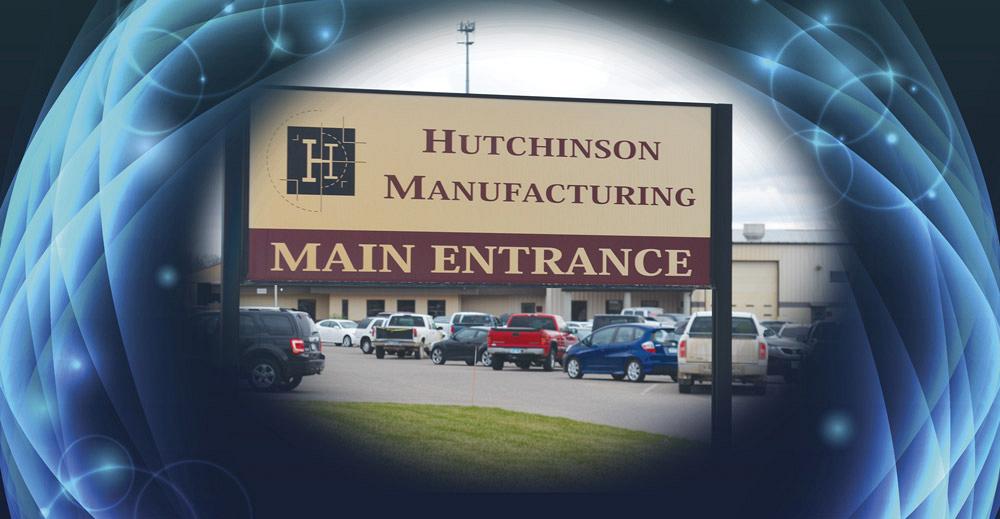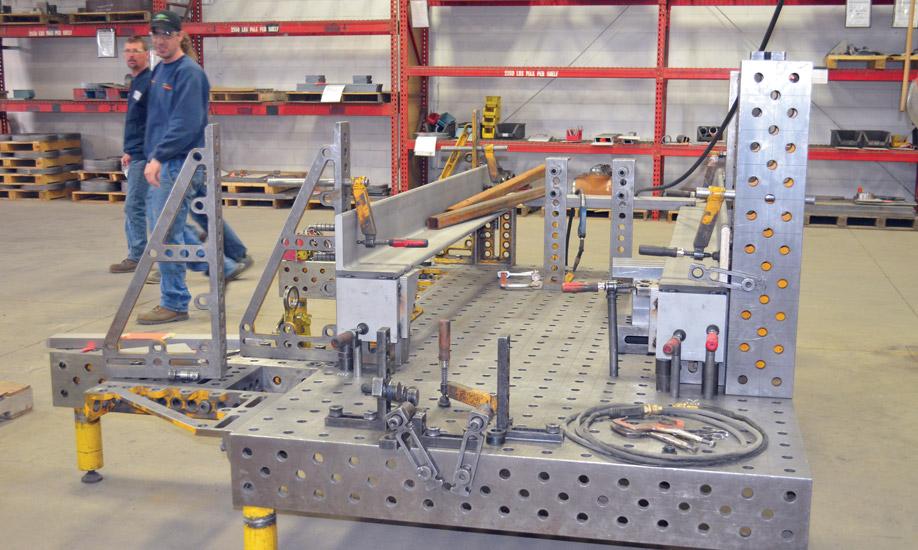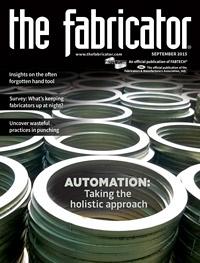Editor-in-Chief
- FMA
- The Fabricator
- FABTECH
- Canadian Metalworking
Categories
- Additive Manufacturing
- Aluminum Welding
- Arc Welding
- Assembly and Joining
- Automation and Robotics
- Bending and Forming
- Consumables
- Cutting and Weld Prep
- Electric Vehicles
- En Español
- Finishing
- Hydroforming
- Laser Cutting
- Laser Welding
- Machining
- Manufacturing Software
- Materials Handling
- Metals/Materials
- Oxyfuel Cutting
- Plasma Cutting
- Power Tools
- Punching and Other Holemaking
- Roll Forming
- Safety
- Sawing
- Shearing
- Shop Management
- Testing and Measuring
- Tube and Pipe Fabrication
- Tube and Pipe Production
- Waterjet Cutting
Industry Directory
Webcasts
Podcasts
FAB 40
Advertise
Subscribe
Account Login
Search
Fabricating skills travel
Hutchinson Manufacturing serves customers far beyond its Minnesota borders
- By Dan Davis
- September 8, 2015
- Article
- Arc Welding

Figure 1
Hutchinson Manufacturing Inc. was founded in 1953 by
Bud and Doris Daggett in a 2,400-sq.-ft. building. Today
the company is led by Bud’s son Tom Daggett, and the
fabricator now occupies 100,000 sq. ft. in separate buildings
on a 10-acre campus.
The tale of the modern-day job shop is not too unlike that of the modern-day worker. It’s all about reinvention to achieve a better standing in the ever-changing economy.
Hutchinson Manufacturing Inc. (HMI), Hutchinson, Minn., has done just that over its 62 years of existence (see Figure 1). In the 1990s it was primarily a fabricator of gauge-thickness sheet metal parts, but that had to change when its largest OEM customer shifted most of its fabricating work to Mexico. In the 2000s the company evolved into a heavy-duty fabricator, and that move has led it to become a shop with a reputation to build plate fabrications that meet high-tolerance specifications.
The story of this job shop transformation really begins with a visit to the annual Offshore Technology Conference in Houston. The trip helped to put the company on a new course where its fabrications would be leaving Minnesota on a regular basis.
From Minnesota to Texas
That trip to Texas proved particularly fruitful for HMI as it developed a key contact with a manufacturer of subsea oil extraction equipment. That led to a contract in 2006 to produce what the customer called its Enhanced Vertical Deepwater Tree (EVDT), which describes these spokes that shoot off from a main oil extraction line and dot the subsea floor underneath the oil rig. This oil extraction equipment can operate at depths exceeding 9,000 feet below the water surface.
From that initial job the oil and gas work has steadily grown for HMI over the years. In 2011 it secured its first multiyear contract to machine subsea components (see Figure 2). In 2012 it acquired additional contracts for subsea machining, including one for cladding the interior of valves with INCONEL® alloy for use in these EVDT setups (see Figure 3). Company officials estimate that they spent about $3 million in capital investments to keep up with these new opportunities, but at the same time, HMI reported annual sales revenues exceeding $20 million. The push to become primarily a fabricator of heavy-duty parts and assemblies was paying off.
The growth wasn’t being fueled by oil and gas work alone, however. In 2009 HMI engaged in discussions with PaR Nuclear, a division of Westinghouse, to partner and build operating cranes for the newly certified AP1000 11-megawatt nuclear reactor design. (The cranes are used to place reactors and to move fuel rods inside the nuclear-generation facilities.) As the partnership moved forward later that year with the construction of a 51,000-square-foot facility next to the HMI campus to house the new endeavor, called NuCrane Manufacturing, the softness in the U.S. economy became evident. HMI stepped up and took a partnership stake, allowing the joint venture to stay on track and start with the fabrication of these high-end cranes.
Also in 2009 HMI achieved ISO 9000 certification and established a Nuclear Quality Assurance (NQA-1) compliant quality program. These quality achievements were important as the company continued to take on more complex jobs in the oil and gas and nuclear industries, with some of the work destined for overseas installations, such as a nuclear facility in China.
“It’s a culture of always thinking of quality. Even if it may be a part that is visually inspected, the part has to be welded right,” said Todd Drahos, HMI’s senior account manager. “The quality always has to be right.”
What Makes the Growth Possible?
Not only does HMI have the certifications to assure customers that its quality commitment is there, but the company also offers nondestructive testing (NDT) as a service. It has several full-time employees working in the NDT lab. Services include magnetic particle testing, a test method used to detect defects at or near the surface of ferromagnetic materials; penetrant testing, which relies on fluorescent dyes to identify surface defects; ultrasonic testing, which uses high-frequency sound energy to penetrate solid material and identify flaws in the part structure; and visual testing that complies with numerous codes or standards.
As part of its NDT services, HMI offers assistance to other manufacturers looking to set up testing procedures to be compliant with certain codes and administer certification training programs. Drahos said the company’s experience working with the oil and gas and nuclear industries has sharpened its focus on quality efforts, both for the company itself and possibly other manufacturers.

Figure 2
HMI has carved out a profitable niche in high-tolerance
machining of large fabrications, such as this assembly
for a subsea oil installation.
“We like to say that we can throw the switch on different quality parameters,” Drahos said.
Supporting those quality efforts have been investments in machine tools to meet the high tolerances customers demand—even in large parts. For example, the company has horizontal boring capability for parts up to 20 ft. long and weighing more than 20 tons.
Downstream, welding investments have been made to ensure quick and correct setups. The welding tables are modular (see Figure 4), and a new laser projector, using HMI’s 3-D CAD models, outlines part layouts on those welding tables. This assists welders in positioning parts with an accuracy down to 0.010 in.
All Under One Roof
“There was a time when we were just taking raw material and cutting it into a shape and sending it off,” Drahos said. “Today we cut it to shape, form it, weld it, machine it, paint it, do assembly work, and send it out.”
Drahos added that as customers ask for more services, HMI considers new opportunities. For instance, the company’s finishing facility, which can handle very large parts in its 15-ft. 4-in. by 17-ft. 2-in. by 60-ft. blast and paint booth, has recently added Xylan® coatings for those oil and gas customers looking for better corrosion resistance.
Without the need to outsource production, HMI can stay on top of quality. Parts are always in the company’s possession, and the shop floor knows where parts are at all times. There are no surprises.
But handling all aspects of the manufacturing process has the additional benefit of controlling the time it takes to produce parts. Drahos said that the lead time for many of the complex fabrications is between 12 and 14 weeks, and that is possible because HMI isn’t dependent on a manufacturing partner trying to balance HMI’s work with other customers’ jobs.
Lean manufacturing activities help to reduce the turnaround time for jobs as well. Drahos said that kaizen events with one of HMI’s oil and gas customers has helped to reduce production time by 10 to 20 percent on key fabrications. These types of activities, combined with first-in/first-out staging locations for “hot” jobs, keep jobs moving through the shop in an expedited manner.
Looking for Talent
About the only thing that is not hitting the HMI shop floor with regularity are new welders and machinists.
“That’s always a big challenge,” Drahos said.

Figure 3
The fabricator has five automated cladding centers from Arc Specialties Inc. that use a hot-wire, gas tungsten arc welding process to apply INCONEL® alloy to the inside of valves used in subsea oil extraction. The added durability is necessary because these valves could be exposed to pressure in excess of 20,000 PSI once they are put in service.
The stories are pretty alarming. There’s the one about the local high school machining class with only two students. There’s the other one about a vocational student who appeared at a meeting of the Minnesota Precision Manufacturing Association to thank the group for a scholarship and had six different individuals hand him a business card and notify him that he had a job waiting for him when he graduated.
The area, unfortunately for employers, is teeming with manufacturers. In fact, 3M has one of its largest manufacturing facilities nearby, which at one time had more than 1,000 employees.
HMI now has a welding apprenticeship program to boost the ranks of its 25 welders. The fabricator, along with other manufacturers, also reached out to a Minneapolis community college to set up a fast-track welding program for manufacturers in central Minnesota.
Dunwoody College, supported by the 15 area businesses that have formed a legal entity called MOVE (Manufacturing Opportunities for Vocational Employment) LLC, has established a training center in Winsted, Minn., to respond to the need for producing more welding talent. Recent high school graduates or adults transitioning from another career can spend 16 weeks in a noncredit, competency-based training program and pick up the welding skills that local manufacturers are looking for.
The first two classes welcomed about 20 students. A third welding class began in late June. A CNC machine operator program was scheduled to begin this fall.
“Rather than having everyone go off and spending two years learning to weld, they can come in and learn really what the companies need in a shorter amount of time,” Drahos said.
Global Demand for the Fabrications
Those welding and machine operator students may not realize how valuable their skills are, but if they go to work for HMI, they’ll learn that lesson quickly. Refined fabricating talent has application not just in Minnesota, but all over the world.
Today Drahos estimates that 70 percent of the company’s work is sent outside the state of Minnesota, with a lot of it heading down south to oil and gas country. That wasn’t the case in the 1990s.
“It says something that they are buying from us, and we are sending it that far. There has to be a lot of sources in between,” he said.
State borders can’t contain fabricating talent.
About the Author

Dan Davis
2135 Point Blvd.
Elgin, IL 60123
815-227-8281
Dan Davis is editor-in-chief of The Fabricator, the industry's most widely circulated metal fabricating magazine, and its sister publications, The Tube & Pipe Journal and The Welder. He has been with the publications since April 2002.
subscribe now

The Fabricator is North America's leading magazine for the metal forming and fabricating industry. The magazine delivers the news, technical articles, and case histories that enable fabricators to do their jobs more efficiently. The Fabricator has served the industry since 1970.
start your free subscription- Stay connected from anywhere

Easily access valuable industry resources now with full access to the digital edition of The Fabricator.

Easily access valuable industry resources now with full access to the digital edition of The Welder.

Easily access valuable industry resources now with full access to the digital edition of The Tube and Pipe Journal.
- Podcasting
- Podcast:
- The Fabricator Podcast
- Published:
- 04/16/2024
- Running Time:
- 63:29
In this episode of The Fabricator Podcast, Caleb Chamberlain, co-founder and CEO of OSH Cut, discusses his company’s...
- Trending Articles
AI, machine learning, and the future of metal fabrication

Employee ownership: The best way to ensure engagement

Steel industry reacts to Nucor’s new weekly published HRC price

Dynamic Metal blossoms with each passing year

Metal fabrication management: A guide for new supervisors

- Industry Events
16th Annual Safety Conference
- April 30 - May 1, 2024
- Elgin,
Pipe and Tube Conference
- May 21 - 22, 2024
- Omaha, NE
World-Class Roll Forming Workshop
- June 5 - 6, 2024
- Louisville, KY
Advanced Laser Application Workshop
- June 25 - 27, 2024
- Novi, MI



























